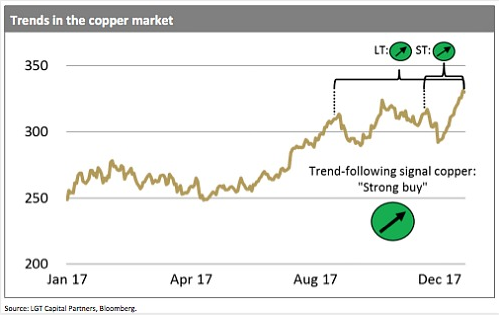The lack of trends outside equity markets has made investing in trend-following strategies difficult. However, should volatility begin to increase again, these strategies could become attractive, LGT's Andreas Vetsch writes.
Von Andreas Vetsch, Hedge Funds Analyst at LGT
 The trend-following approach to trading dates back to the 18th century. British economist David Ricardo, known for his theory of comparative advantage, successfully invested his personal wealth according to a simple rule: «Cut short your losses, let your profits run on.» Trend-following strategies have of course evolved since then, but their long tradition highlights just how robust they are.
The trend-following approach to trading dates back to the 18th century. British economist David Ricardo, known for his theory of comparative advantage, successfully invested his personal wealth according to a simple rule: «Cut short your losses, let your profits run on.» Trend-following strategies have of course evolved since then, but their long tradition highlights just how robust they are.
People Are Herd Animals
Systematic trading strategies always follow an underlying investment theory. In this case, trend followers work on the premise that market information is disseminated slowly among investors and gives rise to trends. For example, if a market participant buys a substantial amount of copper, this leads to a rise in the price of the commodity, which attracts further investors.
Conversely, a sale leads to a reduction in price, which stokes fears and leads to a sell-off. This so-called «herd behavior» demonstrated by investors results in market trends that can be taken advantage of with the help of rule-based trading strategies.
Trends in the Copper Market
However, not every trade is a trend, or triggers such. That is why a clear definition must be established as to when a price movement is considered a trend, that means copper is being bought or sold – so at which point the movement is significant enough. The chart below shows the price movements of copper in 2017:

Trend-following strategies take into account not only long-term trends, but also shorter periods, in order to increase their success rate. The chart illustrates copper’s long-term trend over a number of months. The price increased significantly in the second half of the year – a positive long-term trend can be seen (LT).
The short-term trend (KT) for copper is also positive. If you put the signals for the two periods together, you receive a final trading signal, in this case, a «strong buy». With the help of this strategy, it was easy and quick to identify a clear positive trend in the copper market, which due to investors’ herd mentality, will continue.
More Markets – More trends
Trend-following strategies, are not, however, only straightforward. An added advantage of this systematic approach is its high level of scalability. For example, if desired, several periods can be combined. The focus on short-term trends increases the activity of the strategy and makes it possible to make a quicker adjustment in the event of sudden price breakouts, while long-term trend followers have an advantage in sustained bull or bear markets.
In addition, the strategy can be applied not only across various trend periods, but also in a broad range of markets. On average, around 100 markets are traded at the same time.
Increasing Transparency
Caution should nevertheless be exercised, because trend-following strategies are not a magic bullet. They depend on trends actually being present as well as markets being volatile – and that is not a given. The increasing transparency and more proactive communication by central banks around the world in recent years has on the one hand renewed confidence in the financial system, but on the other hand, also resulted in a significant drop in market volatility and made trend investing more difficult.
In addition, many trends were relatively short-lived and in a number of cases, were actually artificially controlled. But an about-face is emerging: the gradual withdrawal of the central banks could very soon change this, once again making trend-following strategies attractive.
Well-positioned Through Both Bear and Bull Markets
«It’s difficult to make predictions, especially about the future,» Mark Twain once said. Trend-following strategies address this problem. With their help, we look at the past and try to tap into trends that already exist, without having to worry about outlooks or emotions. These strategies generate good returns with a low correlation to traditional asset classes.
In addition, they have the ability to generate profits even during financial market crises and are important building blocks within a traditional portfolio. So let us leave predictions to be just that, predictions. Because as the Greek stateman Pericles once said, it is not our job to predict the future, instead, it is much more important to be prepared for it. An allocation to systematic trend-following strategies is helpful to this end.
Andreas Vetsch is a hedge fund analyst at LGT. His area of expertise is trading strategies. Before joining LGT in 2012, he studied at the University of St. Gallen, where he received a master’s in banking and finance and a second degree in business journalism. A sports enthusiast, he enjoys biking, hiking and skiing.











